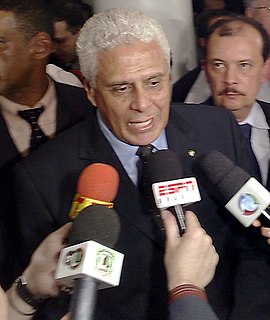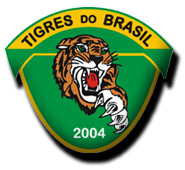
Romário de Souza Faria, known simply as Romário, is a Brazilian politician who previously achieved worldwide fame as a professional footballer. A prolific striker renowned for his clinical finishing, he is regarded as one of the greatest players of all time. Romário starred for Brazil in their 1994 FIFA World Cup success, receiving the FIFA Golden Ball as player of the tournament. He was named FIFA World Player of the Year the same year. He came fifth in the FIFA Player of the Century internet poll in 1999, was elected to the FIFA World Cup Dream Team in 2002, and was named in the FIFA 100 list of the world's greatest living players in 2004.

Duque de Caxias is a city on Guanabara Bay and part of Rio de Janeiro metropolitan area, being the third most populous in Rio de Janeiro state, southeastern Brazil.

Estádio Vasco da Gama, also known as Estádio São Januário, owing to its location on a street of the same name, is the home ground of Club de Regatas Vasco da Gama. Its facade is listed by the National Historical and Artistic Heritage.

Carlos Roberto de Oliveira, known as Roberto or Roberto Dinamite is a Brazilian former footballer and politician. He was born in Duque de Caxias, Rio de Janeiro state. With a career as centre forward spanning over twenty years, Roberto is Vasco da Gama's player with the most appearances and all-time top-scorer, as well as the overall leading scorer in the Brazilian Série A. At the national level, Roberto played in the 1978 and 1982 FIFA World Cups and the 1972 Olympic Games. He was president of Vasco da Gama from 2008 to 2014.
Estádio Nhozinho Santos is a multi-use stadium located in São Luís, Brazil. It is used mostly for football matches and hosts the home matches of Moto Club de São Luís. The stadium has a maximum capacity of 21,000 people and was built in 1950. It is owned by the São Luís city hall, and is named after Joaquim Moreira Alves dos Santos, nicknamed Nhozinho, who introduced football in Maranhão state.

Duque de Caxias Futebol Clube, usually known simply as Duque de Caxias, is a Brazilian football team from the city of Duque de Caxias, Rio de Janeiro state. It plays in the Brazilian Série C which is the third division level of the Brazilian football. The club was founded on March 8, 2005.

Esporte Clube Tigres do Brasil is a Brazilian football team from the city of Duque de Caxias, Rio de Janeiro state, founded on January 19, 2004.

Clube dos Empregados da Petrobrás - Duque de Caxias, usually known as CEPE-Caxias, is a Brazilian women's football team, from Duque de Caxias, Rio de Janeiro state.
Thiago Maciel Santiago or simply Thiago Maciel, is a Brazilian football right back.
Orlando Calisto de Souza or simply Calisto, is a Brazilian left back. He currently plays for Olaria Atlético Clube.
Estádio de Los Larios is a football stadium located in Xerém, a district of Duque de Caxias, Rio de Janeiro, Brazil. The stadium is owned by Tigres do Brasil. It has a maximum capacity of 11,000 people. The stadium is named after the club's founders, the Larios family.
The following article presents a summary of the 2010 football (soccer) season in Brazil, which was the 109th season of competitive football in the country.
The 2010 Copa do Brasil de Futebol Feminino was the fourth staging of the competition. The competition started on August 16, 2010, and will conclude on December 4, 2010. 32 clubs of all regions of Brazil participated of the cup, which is organized by the Brazilian Football Confederation (CBF). The winner of the cup represented Brazil in the 2011 Copa Libertadores de Fútbol Femenino.

Duquecaxiense Futebol Clube, commonly known as Duquecaxiense, is a Brazilian football club based in Duque de Caxias, Rio de Janeiro state. The club was formerly known as Associação Atlética Duquecaxiense.
Cássio Alves de Barros is a former Brazilian footballer.
Matheus Cardoso de Souza, known as Matheus Ortigoza, is a Brazilian footballer who plays for Mogi Mirim, on loan from Duque de Caxias, as a forward.
Antônio Lopes dos Santos Júnior, known as Júnior Lopes, is a Brazilian football assistant manager for Cruzeiro Esporte Clube.
Alfredo Sampaio is a retired Brazilian football defender, and now a manager.
Geferson Cerqueira Teles, known as Geferson, is a Brazilian professional footballer who plays for CSKA Sofia as a left back.
Romário de Souza Faria Filho, commonly known as Romarinho, is a Brazilian footballer who plays for Tupi as a forward.











